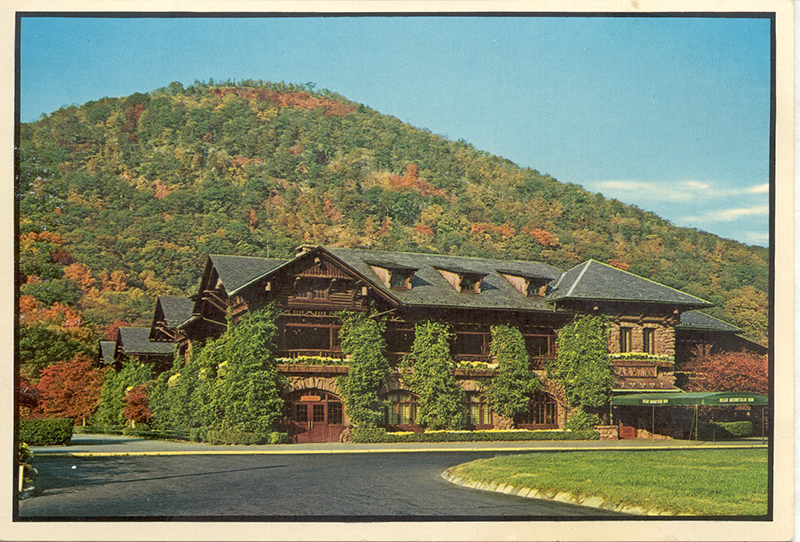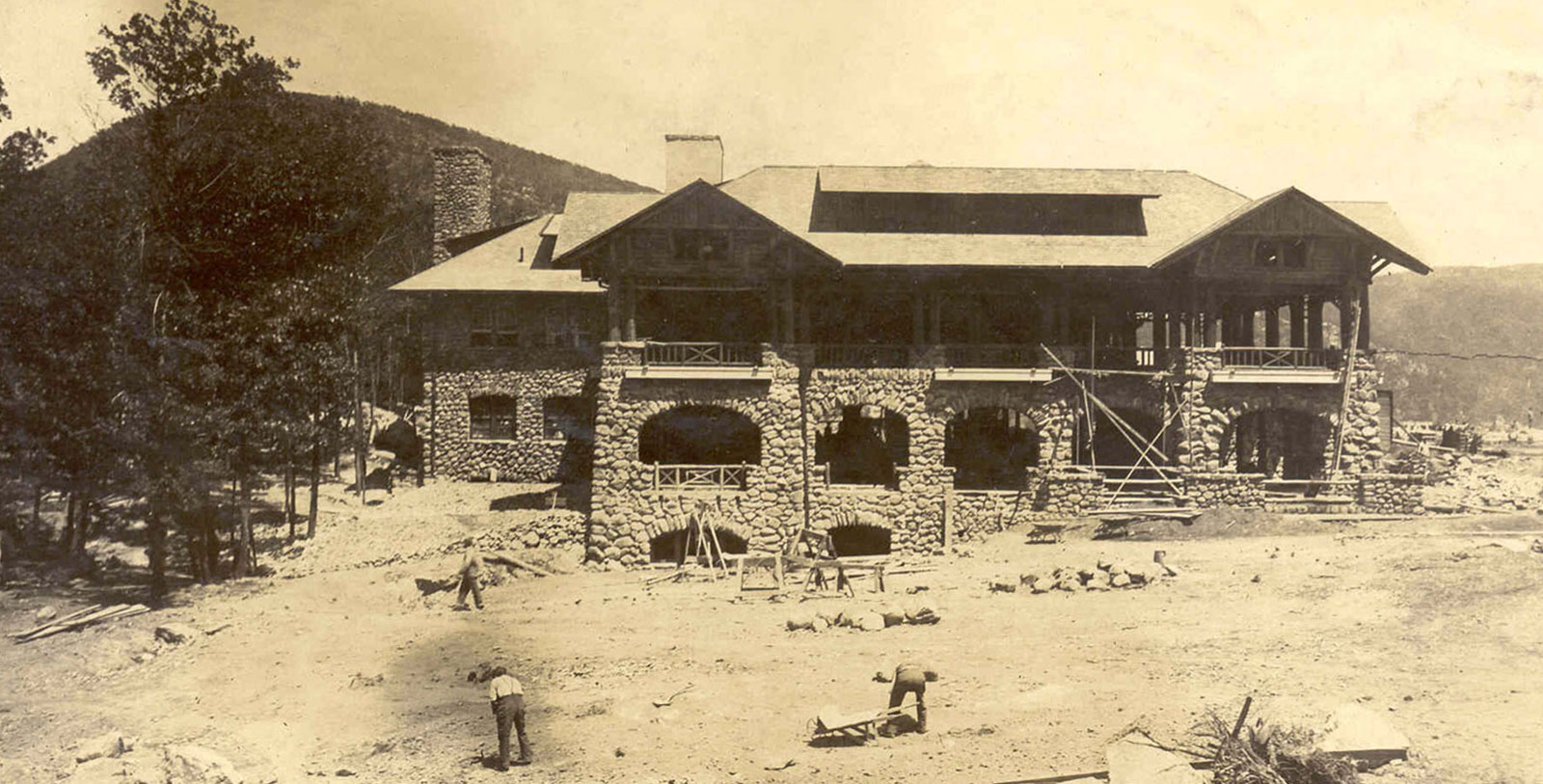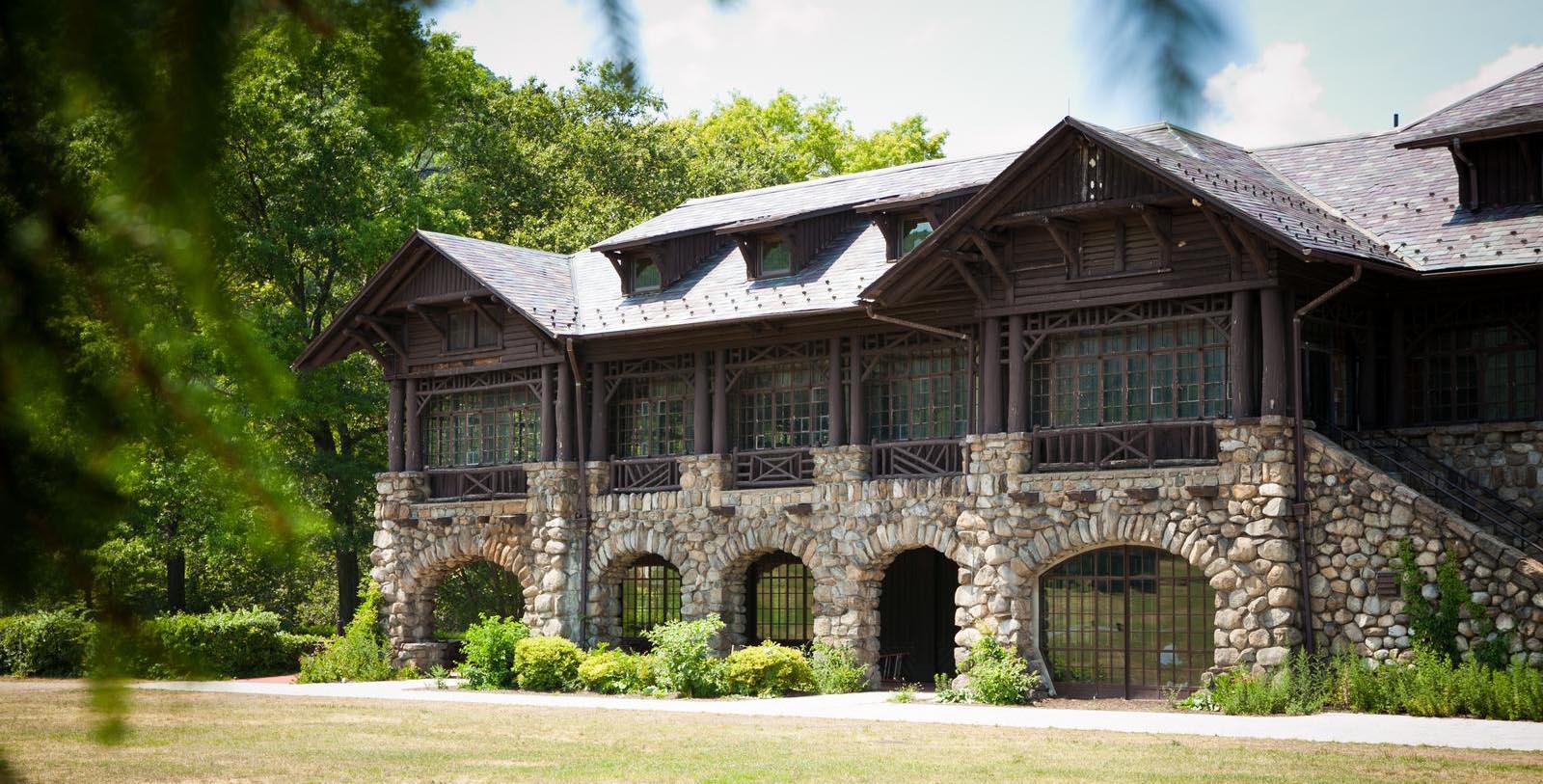Receive for Free - Discover & Explore eNewsletter monthly with advance notice of special offers, packages, and insider savings from 10% - 30% off Best Available Rates at selected hotels.
historic new york hotel: bear mountain inn
Discover Bear Mountain Inn, which was one of the earliest rustic-style lodges to take advantage of the natural setting of Bear Mountain.
Bear Mountain Inn, a member of Historic Hotels of America since 2016, dates back to 1915.
VIEW TIMELINE
100th Anniversary of the Bear Mountain Inn Film
On June 12, 2015, the Palisades Parks Conservancy celebrated the 100th Anniversary of the Bear Mountain Inn. This film tells the story of the People's Inn over its century-long lifespan.
WATCH NOWListed on the U.S. National Register of Historic Places, the Bear Mountain Inn is among the most iconic landmarks in the Hudson Valley. This fantastic wilderness retreat has been owned and operated by New York’s Palisades Interstate Park Commission ever since it first opened. The agency itself formed a decade prior via an interstate compact signed by Theodore Roosevelt and Foster M. Voorhees, who were then the respective governors of New York and New Jersey. Both men hoped that the Palisades Interstate Park Commission would conserve the line of cliffs extending that lined the southern banks of the Hudson River. The organization thus pursued many strategies to build public concern for the region, going as far as to construct several unique tourist attractions within a few local state parks. One of those parks was the newly created Bear Mountain State Park, which had come into existence formally in 1913. Among the many distinctive facilities that the Palisades Interstate Park Commission developed was the Bear Mountain Inn. The commissioners believed that a marvelous hotel would encourage travel to the park, as people sought momentary respite from the rancor of city life further south. The agency’s commissioner, George W. Perkins, specifically desired to recreate the pastoral majesty of the grand lodges found in Yellowstone National Park and Grand Canyon National Park.
To that end, the organization hired the architectural firm Tooker and Marsh to create a fantastic wilderness retreat that could encapsulate the rural ambiance of Bear Mountain. In just nine months, Tooker and Marsh created a brilliant multistory lodge called the “Bear Mountain Inn.” What stood was one of the earliest examples of the rustic, outdoor architecture that would soon define the buildings created throughout most of America’s national and state parks. Chestnut timber helped achieve this character, for it was used to construct the siding, the floor coverings, and exterior trimming. It was even used to create a significant portion of the frame! Stone from old colonial boundary lines were used to build the foundation, as well as two remarkable fireplaces. But despite its rather pastoral character, the inn contained a wealth of amenities considered modern for their age. For instance, the cellar housed an electrical plant that flooded the building with artificial light. A grand lunch counter resided on the first floor, as well, while a wonderful fine dining establishment offered world-class service up on the second story. Steam heat and enclosed windows later appeared, too, enabling the inn to become a year-round facility.
The Palisades Interstate Park Commission debuted the Bear Mountain Inn with an invitation-only soiree on June 26, 1915. Many of New York’s powerful political figures and renowned families came to the event, which was presided over by Governor Charles S. Whitman. Its bucolic eloquence and secluded appeal quickly impressed all in attendance. As such, word soon spread about inn throughout the region. Hundreds of visitors flocked to the Bear Mountain Inn, reaching the destination by steamship, train, and automobile. All were stunned that such a retreat could be a publicly-owned facility. By the height of the Roaring Twenties, the Bear Mountain Inn had become the most exclusive holiday destination in the entire Hudson Valley. The business never relinquished that distinction, either, hosting countless luminaries from across the nation over the next few decades. Prominent musicians, such as Harry James and Tommy Dorsey, brought their bands to the Bear Mountain Inn to play before its throngs of guests. Numerous national sports teams also reserved blocks of guestrooms for their players, too, including the New York Knicks, the New York Yankees, and the Brooklyn Dodgers. U.S. Presidents like Franklin Delano Roosevelt and Harry S. Truman even sojourned to the Bear Mountain Inn for some much needed rest and relaxation. Today, the Bear Mountain Inn is still among the best places to visit in upstate New York. A member of Historic Hotels of America, its amazing historical character and rustic architecture have since made it one of the most vibrant members of the collection and prominent among our historic New York hotels.
-
About the Location +
Bear Mountain is among the most celebrated locations in New York’s Hudson Highlands. The Highlands themselves have long been inhabited by humans, with Native Americans of the Lenape (otherwise known as Delaware) people occupying the region centuries ago. Many of the first Europeans settled the area in the 17th century, when Dutch colonists made their way north up the Hudson River to the site of present-day Albany. The mountains later became a strategically important location during the American Revolution, as the Continental Army sought to control its local passages. They hoped that such an act would prevent the British from isolating New England from the rest of the colonies. It was also the site of the original Hudson River Chain, which innovative American engineers constructed as a means of stopping local British commerce heading south down from Canada. The chain specifically hung several miles upriver from Bear Mountain, where it draped across the water at both West Point and Constitution Island. The Hudson Highlands later became the home of Thomas Cole’s 19th-century artistic movement, which used its rugged—yet picturesque—landscape as the source of its inspiration. Art historians today often refer to Cole’s artistic philosophy as the Hudson River School.
Love for the area’s natural beauty persisted into the 20th century, as local conservationists fought to protect the land from the encroachments of commercial developers. As such, those early environmentalists managed to inspire the State of New York to create a number of public parks throughout the region. One of those fantastic destinations was Bear Mountain State Park, which formally opened in 1913. Bear Mountain State Park was specifically born from the generous donation of Mary Averell Harriman, who gave some 10,000 acres of her own estate—as well as one million dollars—to preserve the area around Bear Mountain. Her cause proved to be so attractive that she even enlisted the help of prominent businessmen like John D. Rockefeller and J.P. Morgan. Nearly half of the donation went toward creating the nearby Harriman State Park in 1910, while Bear Mountain State Park debuted some three years later. Authority over those two parks had been given to the Palisades Interstate Park Commission, which had been formed a decade prior in order to protect the geography along the Hudson River. The entire locale surrounding Bear Mountain had emerged as a major tourist attraction by this point, entertaining thousands of guests every year. Both Harriman State Park and Bear Mountain State Park remain two of the most heavily visited outdoor destinations in New York today.
-
About the Architecture +
The specific architectural style that characterized the Bear Mountain Inn's overall appearance is best defined as “National Park Service Rustic.” As the name would suggest, the form first became prominent in the United States before its spread throughout the rest of North America. Architect Herbert Maier conceptualized the aesthetic while he was studying the Arts and Crafts movement at the University of California, Berkeley, in the early 20th century. Rejecting the design aesthetics of industrialized society, Maier created an architectural form that utilized building materials to better connect a structure to its natural surroundings. Following his graduation from school, he quickly set about designing several structures with his novel architectural approach. Maier found a particularly receptive audience at the National Park Service, as many alumni—including his friend Ansel F. Hall—had graduated from the University of California, Berkeley around the same time. Other architects then adopted Maier’s mentality and it quickly became the preferred architectural style of the National Park Service. Many state governments soon embraced the eclectic design philosophy, too, using the rustic style to create all kinds of public structures within their own park systems. New York was one such state that relied upon Maier’s form, developing it everywhere from the Hudson Valley to the Adirondack Mountains. Its use only became more widespread in America when the Civilian Conservation Corps began erecting dozens of new park structures during the 1930s. Yet, its popularity throughout North America eventually waned by the middle of the century, as architects began embracing newer design philosophies.
-
Famous Historic Guests +
Harry James, big band leader known for working alongside the likes of Frank Sinatra, Benny Goodman, and Louie Bellson.
Tommy Dorsey, jazz musician known for such songs like “Opus One,” “Song of India,” and “I’ll Never Smile Again.”
Soong Mei-ling, former First Lady of the Republic of China.
Eleanor Roosevelt, First Lady to former U.S. President Franklin Delano Roosevelt (1933 – 1945)
Franklin Delano Roosevelt, 32nd President of the United States (1933 – 1945)
Harry S. Truman, 33rd President of the United States (1945 – 1953)
Dwight D. Eisenhower, 34th President of the United States (1953 – 1961) and Supreme Allied Commander of Europe during World War II
Richard Nixon, 37th President of the United States (1969 – 1974)
-
Film, TV and Media Connections +
Whistling in Brooklyn (1943)
The Seven-Ups (1973)
Devil’s Express (1976)
I, the Jury (1982)
Barcelona (1994)
The Juror (1996)
Fallen (1998)
At First Sight (1999)
Kaaterskill Falls (2001)
The Sopranos: Pine Barrens (2001)
Pieces of April (2003)
The Good Shepherd (2006)
The Following: Forgive (2014)
The Girl of the Train (2016)
Puzzle (2018)
-
Women in History +
Eleanor Roosevelt: The Bear Mountain Inn has hosted countless luminaries throughout its history, ranging from Hollywood celebrities to notable politicians. Among those illustrious individuals who stayed at the inn on numerous occasions was former First Lady Eleanor Roosevelt. She was born Anna Eleanor Roosevelt in 1884, the daughter of Elliott and Anna Hall Roosevelt. A member of the Oyster Bay clan of the Roosevelt dynasty, Elliott himself was the brother of U.S. President Theodore Roosevelt. Roosevelt’s immediate family cherished community service, although both her parents died at an early age. Her intellectually progressive outlook on life was further reinforced by Marie Souvestre, who was Roosevelt’s headmistress during her time in London’s prestigious Allenswood Boarding Academy. Nevertheless, she kept those personal influences close to her heart, and used them as the foundation for her future work as a social activist. Indeed, some of her earliest work involved tending to the overcrowded tenement houses in New York City’s Lower East Side.
Around the same time, she began courting her distant cousin, Franklin Delano Roosevelt. They eventually married in 1905 and had six children together. Yet, the marriage was strained by the two’s dueling personalities, as well as the demands of her husband’s early political career. Roosevelt often felt her responsibilities as a “political wife” were tedious, especially after Franklin’s appointment as the Assistant Secretary of War shortly before the outbreak of World War I. Their marriage further deteriorated in 1918, when Eleanor discovered that Franklin had an affair with their mutual friend, Lucy Mercer. Roosevelt, thus, vowed to throw herself fully back into her political activism. But the two had a strong understanding that their fates remained intertwined and aspired to support one another going forward. It was Eleanor who encouraged Franklin to remain in politics when he was beset with polio in 1921. As such, Eleanor Roosevelt was incredibly instrumental in aiding her husband’s election as the Governor of New York in 1928, as well as his subsequent rise to the presidency four years later. She often gave numerous speeches in public on his behalf that galvanized thousands of people. Roosevelt also became a central figure at his campaign events, serving as her husband’s voice whenever he could not attend.
But Eleanor Roosevelt still established her own vibrant political career as the First Lady of the United States. Historians today consider her actions to have fundamentally transformed the role that the First Lady traditionally held within the national government. Roosevelt used her position to advance a number of causes close to her heart, including gender equality, civil rights, and housing reform. For instance, she arranged a massive celebration at the nearby Lincoln Memorial to protest the racist decision of the Daughters of the American Revolution to not let Marian Anderson—an African American opera singer—perform at Constitution Hall. On another occasion, she privately lobbied for the passage of the Costigan-Wagner Bill, which would have made lynching a federal crime. Roosevelt also held exclusive press conferences at the White House for female journalists, in order to help enable women to break into the field. She even attempted to create an experimental community in West Virginia called “Arthurdale,” where homeless miners would have a shot at achieving a new, independent life. Although considered a failure, it was testimony to her commitment to enhance the lives of countless others.
Eleanor Roosevelt’s historic career continued well after her time at the White House ended in 1945. She played a significant role in turning Hyde Park into a museum dedicated to her late husband’s legacy, which set a precedent for future presidential libraries to follow. She also served as a delegate to the United Nations Commission on Human Rights, becoming its chairperson in 1947. Roosevelt remained with the organization until 1953, and her political insight proved integral toward drafting the Universal Declaration of Human Rights. After working to reform New York politics throughout the remainder of the decade, Roosevelt eventually worked to support the campaign of John F. Kennedy. While she initially rebuffed Kennedy for his refusal to denounce McCarthyism, Roosevelt relented on the grounds that she believed he had the best chance of leading the nation into the future at the time. When Kennedy won in 1960, she became his representative to such organizations like the National Advisory Committee to the Peace Corps. Then, in 1961, Kennedy appointed her as the First Chair of the Presidential Commission on the Status of Women. But Roosevelt would not see the commission come to fruition, as she died mere months after it was organized. Eleanor Roosevelt has since been revered as one of the most influential figures in 20th-century American history and is esteemed across the world today for her years of advocacy.































